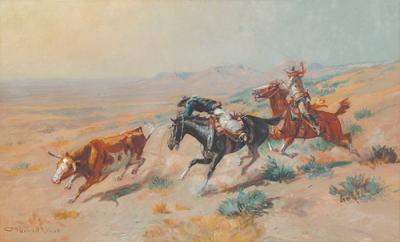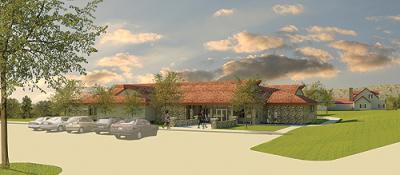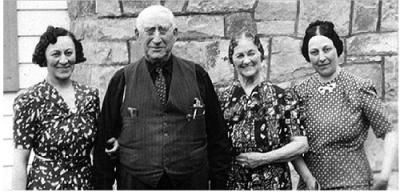The Bair Museum's Elegant Expansion

Near the confluence of the North and South Forks of the Musselshell River, the Charles M. Bair Family Museum stands as a tribute to the early day sheepman C.M. Bair. His daughters, Marguerite and Alberta, gathered the treasures of the family in a museum to tell their story and dedicated it to the people of Montana and the nation. In July, the doors will open for a new building on the grounds to house the unique treasures of Western artists Charles Russell and Joseph H. Sharp, photographer Edward Curtis, and the unique Plains Indian collection. Copies of the art works will be in the museum proper to continue the Bair Family story as the Bair sisters designed.
Charles M. Bair came to Montana in 1883 as a conductor on the railroad, but he soon changed his occupation to rancher. In the course of a few years he was raising sheep in the Lavina area and moved to Billings. A fortuitous trip to the Klondike during the gold rush and a 10-year lease on the Crow Reservation made him the largest sheep raiser in the country. One of his many acquisitions was the Martinsdale ranch where he made his Montana headquarters and where the family moved permanently in 1932.
While leasing land on the Crow Reservation, Bair was one of Joseph Sharp’s best customers. Sharp and his wife, Addie, had come to Crow Agency in the summer of 1899. Sharp was drawn by the culture of the Crows, the proximity to Custer battlefield, and a great desire to paint the Plains Indians. He was busy working on an order from Phoebe Hearst, widow of Senator George Hearst and mother of William Randolph Hearst, for paintings to hang in a memorial building for Senator Hearst at the University of California.
Sharp also depicted Charlie’s “favorite fishing hole.” He painted two still lifes of apples; Bair promptly bought one and gave it to the Reynolds Family. Sharp had used Carrie Reynolds’ “butter bowl” in the one Bair kept for himself.
Bair bought work from his friend Charlie Russell early in the century. Sometimes in California, Bair, Russell, Curtis, actor Tom Mix, and others, gathered to share stories of their years in the West. These were good stories—good memories.

Another artist, photographer, Edward Curtis, took pictures on the Reservation, and Bair bought the Crow folios from him to help finance his work. Curtis had embarked upon a project of capturing the Indian nations on film and his depiction of the Crows was exceptional. These excellent pictures of the Crow will be shown in the protected atmosphere of the new building, while some copies will continue to be shown in the house.
Years after the Crow project, Curtis had a studio in California at the Biltmore when Bair and his family spent the winters there. When Alberta complained that her father wouldn’t sit for a photograph, Curtiss told her to bring her father and Charlie Russell down to the studio and he would catch both of them. Those two photographs are on the mantel in the Pine Room at Martinsdale.
Curtis was also a member of the party that escorted the French Ambassador and his wife to visit the Crow Reservation. The couple arrived in Billings for a one-day stopover en route from San Francisco to Washington and was to be shown something of the country and the resources and industries. The program called for a stop at the shearing pens at Kaiser where Bair’s sheep were being sheared. They were then to go to Pryor so that the guests could learn something about the Indians. Bair had arranged for a big welcome.
Two hundred Indians in full war paint and regalia, filling the air with war whoops and gunfire, descended upon the cars and surrounded them. As the Indians circled the cars—a tremendous show!, Bair beamed with satisfaction and turned to accept the reactions of his guests, only to find them panic-stricken on the floor of the car.
A large picture by Ken Ralston was commissioned in 1951 by the Bair sisters to hang in the new Office Room over the bar. The painting was to commemorate Charlie Bair’s negotiating with the Crows. When it was delivered, Marguerite had him take it back to Billings and add “some red,” the color of the new carpet in the room. Ralston added a red blanket on one of the Indians—and then, with a smile undoubtedly, added red hair to the cowboy. The Bair sisters placed the headdress (purportedly Plenty Coups) by the picture and a ceremonial pipe. The bright vest that belonged to one of Buffalo Bill’s bartenders and leather pants of the warrior “Rain in the Face” were arranged to the right.

The Bair ladies—Mary, Marguerite, and Alberta—collected art and antiques from their Portland home, and when the family moved to Martinsdale permanently, the sisters deftly joined their collections with the Western art to tell the story of Charles Bair and his family. Alberta and Marguerite continued to visit Europe many years to enlarge the collection and today the Western and European art hang comfortably together. The Parisian “firelight” scenes by Edward Cortez are a particular favorite of visitors.
In order to preserve these priceless art pieces, the originals will be housed in the new building and copies will be displayed in the House Museum to fully tell the Bair story.
The exterior of this new museum building, according to Kim Olsen of O2 Architects of Billings, has been carefully designed to blend with existing structures on the property while the interior is designed to exhibit paintings and collections gathered by the Bair family. According to Director-Curator Elizabeth Guheen, the design includes gallery space for Charlie Bair’s collection of Russells, Sharps, and J.K. Ralston as well as a separate gallery for the Bair sisters’ American and European paintings. A specially designed gallery space has been created to show the valuable, but light sensitive photographs of Edward Curtis—only a few copies of which have been shown in the house. The museum will also be available for guest exhibits.
Climate and light controlled glass display cases have been designed for the Bair’s Native American art and artifacts. In addition, there is a temporary gallery space for revolving exhibits and a cement vault for storing pieces during off-season months.
Ceremonial ground breaking for the building was in August of 2010 and construction began in the fall. The Grand Opening is scheduled for July, 2011.
The summer hours for the Museum will be May through September, 10 a.m. to 5 p.m.—last tour of the home is at 4 p.m.
Lee Rostad and her husband Phil ranched in the northern foothills of the Crazy Mountains, not far from the Bair Ranch. Rostad wrote a biography of Charlie Bair, Fourteen Cents and Seven Green Apples, and a history of the museum and the fight for its survival, The House of Bair: Sheep, Cadillacs and Chippendale. She has also written Grace Stone Coates, Her Life in Letters. The recipient of many honors, Lee currently lives in Helena and serves on the Montana Historical Society Board.
Leave a Comment Here
Leave a Comment Here